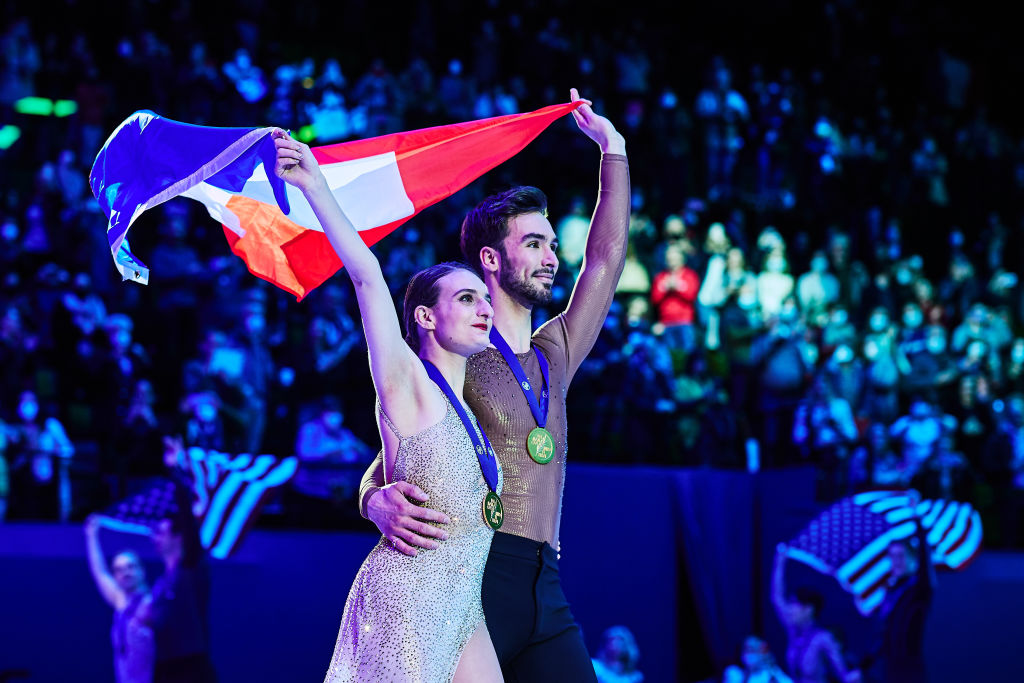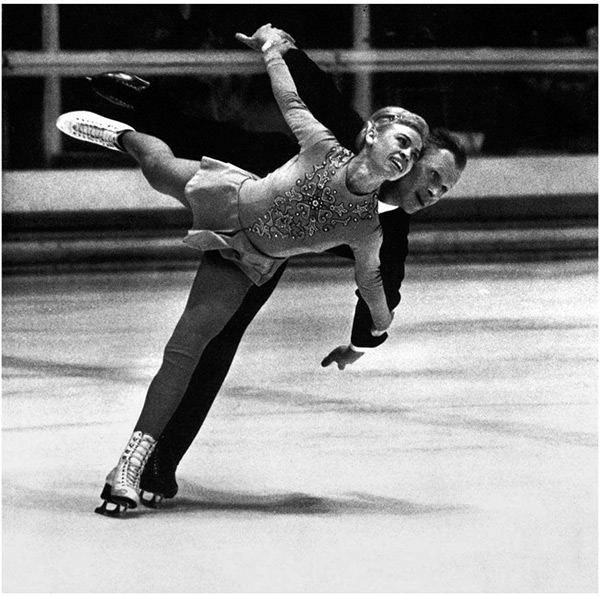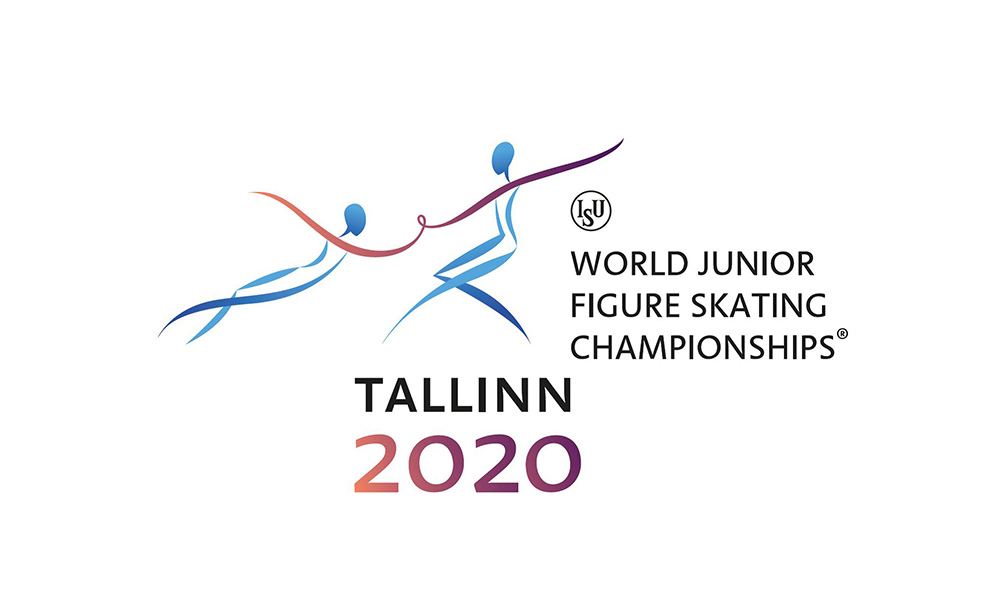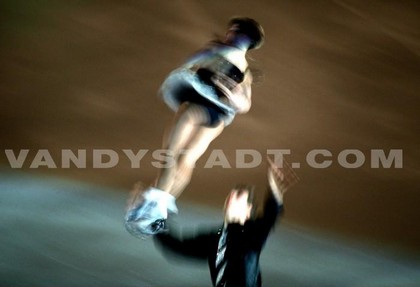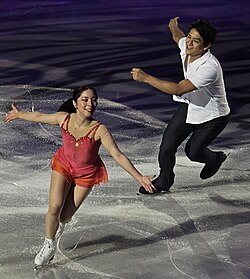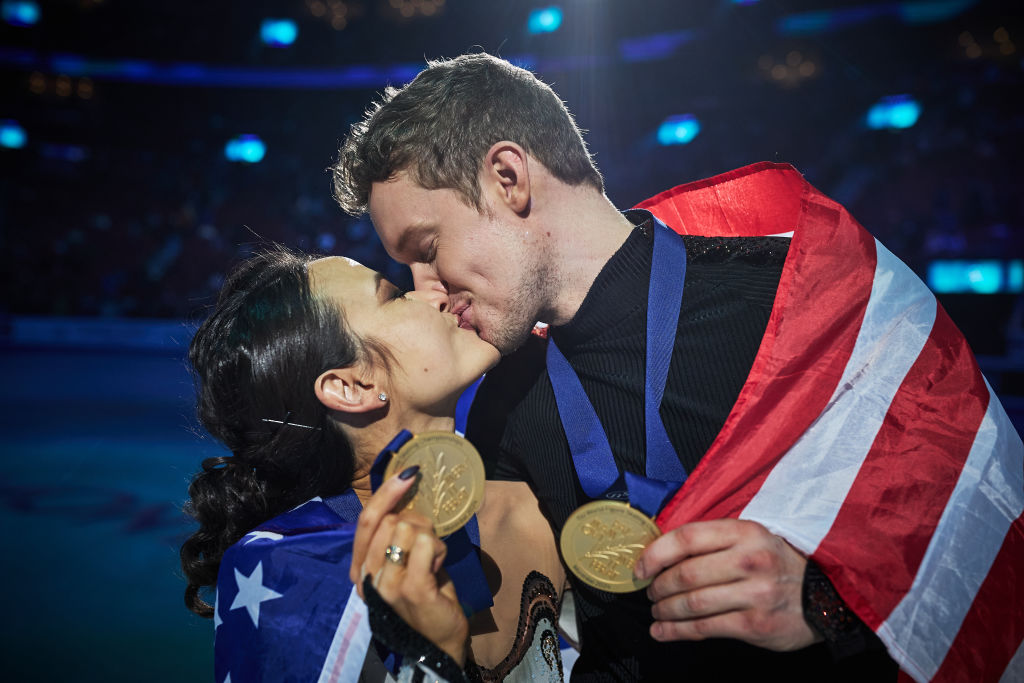| Happy Birthday : |

Axel Jump
Named after its Norwegian originator Axel Paulsen, the Axel jump takes off from the forward outside edge of one foot and lands on the back outside edge of the opposite foot. A single Axel is 1 ½ revolutions, a double is 2 ½ revolutions and a triple Axel is 3 ½ revolutions. It is the only jump that begins from the forward facing position.
Blade
Modern figure skate blades are slightly curved, with a sweet spot or equilibrium area underneath the ball of the foot. The bottom quarter-inch of the blade is made from a special type of steel that maintains a sharp edge.
Camel Spin
A spin on one leg with the free leg extended parallel to the ice and the upper body inclined forward with extended arms.
Combination Spin
A spin where the skater changes positions, and sometimes feet, while maintaining speed throughout the entire spin.
Compulsory Dance
Compulsory dance is the first segment of the ice dance competition. All couples skate the same dance which is pre-determined prior to the start of the event.
Crossover
A method of gaining speed by skating with one foot crossing over the other. There are forward and backward crossovers.
Death Spiral
An element used in pairs skating, this move involves the man spinning in a pivot position while holding one hand of the woman who is spinning in a horizontal position with her body parallel to the ice.
Edge Jump
A jump in which the skater takes off from his/her skating foot without bringing the free foot in contact with the ice to assist takeoff. The Axel, Salchow and Loop are common edge jumps.
Edges
The two sides of the skate blade. The inside edge is the edge on the inner side of the leg, while the outside edge is on the outer side of the leg. There are also forward and backward edges.
Flip Jump
A toe pick-assisted jump launched from the back inside edge of one foot and landed on the back outside edge of the opposite foot.
Flying Sit Spin
A spin in which the skater leaps off the ice, assumes the sitting position at the peak height of the jump, and lands in the sitting position on either foot.
Free Dance
In the free dance, skaters select the mood and tempo of their music but some required and specified elements must be included in the four-minute program. Skaters are encouraged to display a full range of technical skills using creative and original choreography.
Free Skating
The free skate is the final part of singles and pairs competition. Skaters select their music and create their choreography to best display their technical and artistic skills. The free skate is limited to four and a half minutes for men and pairs, and four minutes for ladies.
Hand-to-Hand Loop Lift
A lift in which the man raises his partner above his head while she is facing the same direction. She remains facing the same direction in a sitting position with her hands behind her while he supports her hands with his.
Hand-to-Hand Lasso Lift
An overhead lift in which the female partner rotates on the way up.
Jump Combination
Combining several jumps so that the landing edge of one jump serves as the takeoff edge of the next jump.
Lateral Twist
A move in which the man throws his partner overhead. She rotates one time, or more, while in a lateral position to the ice, and is caught before being set down gently on to the ice.
Layback Spin
Generally performed by women, the skater positions her arms in a circle in front of her body and arches her back and shoulders facing up toward the ceiling while spinning.
Lifts
The man lifts his partner above his head with his arms fully extended. Lifts consist of controlled ascending, rotational and descending movements.
Line
A skater's position relative to the ice.
Long Program
Another term for the free skating portion of the singles and pairs competitions. See free skating.
Loop Jump
An edge jump launched from a back outside edge and landed on the same back outside edge.
Lutz Jump
Named after its inventor Alois Lutz of Austria, the toe pick-assisted jump is launched from a back outside edge and landed on the back outside edge of the opposite foot. The skater glides backward on a wide curve, taps his/her toe pick into the ice and rotates in the opposite direction of the curve.
Mirror Skating
Opposite movements performed by a pair of skaters in close proximity to one another.
Original Dance
Original dance is the second segment of the ice dance competition.
Overhead Lifts
A pairs lift in which one or both of the man's arms are fully extended as he holds his partner overhead. The man does not let go of his partner during the lift, except momentarily during changes in her position or during the dismount.
Platter Lift
A lift in which the man raises his partner overhead with his hands on her hips. She extends her body horizontal to the ice in a position that resembles a waiter holding a serving dish.
Quadruple Jump
Any jump of four or more (but less than five) revolutions.
Salchow
Created by Ulrich Salchow
, this edge jump is launched off the back inside edge of one foot and landed on the back outside edge of the opposite foot.
Scratch Spin
One of the most basic of all spins, the scratch spin is difficult to execute correctly. The skater stands up straight on the left leg while spinning on an inside edge. The right leg is extended in front of the body with the thigh raised high, and the arms are up and out to the side. Bringing in the free leg and arms accelerates the spin.
Shadow Skating
Identical movements performed by a pair of skaters in close proximity to one another.
Short Program
The short program is the first segment of the competition in singles and pairs skating. It consists of required elements that are performed by all competitors.
Single Jump
Any jump of one or more (but less than two) revolutions.
Sit Spin
A spin performed in a sitting position, close to the ice and with the skating, or spinning leg, bent at the knee and the non-skating, or free leg, extended.
Spins
Skills in which skaters rotate on their vertical axes while maintaining contact with the ice with one or both skates.
Spiral
During a long glide across the ice, the skater extends the non-skating leg into the air behind them demonstrating flexibility and poise.
Star Lift
An overhead lift where the partners face each other and the woman is raised over the man’s head using a hand-to-hand grip with one arm, and a hand-to-hip grip with the other arm. Both of the man’s arms are fully extended. The woman is in a scissors position in the air with one hand clasping one of the man’s hands and the other on his shoulder.
Step Sequence
A sequence of steps that immediately follow one another, performed in time to music.
Throw Jump
A pairs skating move in which the female partner is thrown into the air by the man and lands, without assistance, on a backward outside edge. Depending on her number of revolutions, throw jumps can be single, double, triple or quadruple.
Toe Loop
A toe pick-assisted jump that takes off and lands on the same outside edge.
Toe Overhead Lift
A lift in which the man swings his partner from one side of his body, around behind his head, and into a raised position. The woman faces the same direction as the man, in a split position.
Toe Pick
The teeth cut into the front tip of the blade which are used for pushing off in jumps and as the pivot point during spins.
Triple Jump
Any jump of three or more (but less than four) revolutions.
Twist Lift
A pairs skating lift in which the man lifts his partner over his head and tosses her in the air, where she rotates and then is caught and placed back gently on to the ice. Depending on the number of revolutions, a twist lift can be single, double, triple or quadruple.
Upright Spin
Executed forward or backward, the basic upright spin consists of an erect posture with the free foot held next to the skating foot and the side of the toe touching the calf of the skating leg.
Waltz Jump
Skaters launch into the air from their forward outside edge and complete a half rotation.
Copyright Sportquick/Promedi




